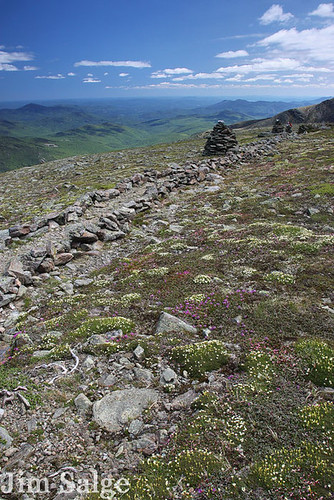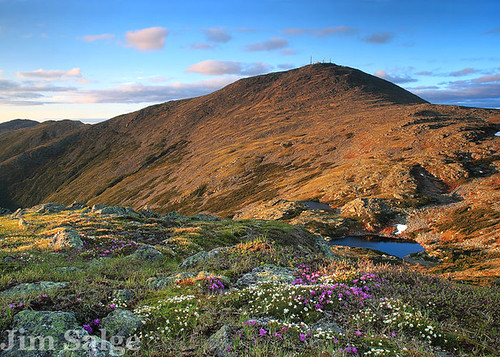Alpine Flowers in the Northeast
The land above treeline in the White Mountains has been described as an arctic island in the sky. Plants that were once prevalent all over New England after the last ice age have retreated to the only place they can out compete other species, and where few other plants can tolerate living. To find similar species in any abundance, you’d have to travel to near the arctic circle, and some plants are found nowhere else on Earth.
Most of the year, these plants look lackluster at best, and most times downright drab. Cushion plants that grow extremely low to the ground, and sedges spend ten months a year decked in the color brown are rarely a cause for pause. For a few short weeks a year thought, the tundra undergoes a rapid transformation into a lively and vibrant colorscape.
I set out this week to tour around the summit cone of Mount Washington, and immerse myself in, enjoy and document this year’s bloom of alpine flowers. The weather did not cooperate with my plans, which is usually the case in the “Home of the World’s Worst Weather.” The days before my planned visit, temperatures dipped, winds blew a hurricane, and ice coated the upper cone. But these plants are hearty, and have seen adversity before. Saturday, as ice clung to the cairns, the flowers melted out and continued the show. And it was beautiful.

The Alpine Garden Trail on Mount Washington
The three common species of plants on Mount Washington are Diapensia, Lapland Rosebay and Alpine Azalea. The latter of the two closely resemble miniature versions of shrubs in my yard, and the diapensia is all together unique. The flowers are easily the largest feature of the plants, and starkly stand out against the low landscape. It inspires awe, and for me, art.

Alpine Plant Community
The beauty of these plants call me to the summits every June, and Saturday, the perfect weather drew me to stay out late. I scouted a scene on Mount Monroe, and waited and hoped for soft sunset light for a few hours. When the sun finally dipped below the clouds and lit the summit cone, I was able to capture an image I’ve visualized for years. An image I hope can lend itself to further education and protection of this fragile environment.

Sunset from Mount Monroe
Great effort and care needs to be taken to protect these fragile post-glacial relics, and many organizations have really gone to bat for them. Scree walls line the most fragile areas, funneling traffic away from plant communities susceptible to damage from even minor human traffic. Efforts in education and conservation have paid off as well. The entire Crawford Path was even redirected away from the endemic and formerly endangered Dwarf Cinquefoil, which is one of under two dozen species to have ever been taken off the Federal Endangered Species List.

Dwarf Cinquefoil
There are many great ways to support the work of those working to protect the New England Alpine Zone, and the AMC has a citizens scientist program that you can get involved with as well. I encourage anyone visiting the alpine zone in the next few weeks to find out more about the landscape through these links:
Beyond Ktaadn: http://www.beyondktaadn.org/ktaadn/home.html
AMC Mountain Watch: http://www.outdoors.org/conservation/mountainwatch/index.cfm



Jim, this is SUCH an outstanding shot!! Good visualization. Perseverance wins every time.
Nice work, Jim. I have always wondered about the alpine flowers as subject matter and you have captured them beautifully. I particularly like the scene on Mt Monroe! By the way, I came across your site on NPN – I was a member years ago (I live in Portland, Maine) and am now just getting back into it. Looking forward to seeing more of your work.
Fred